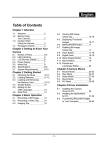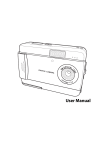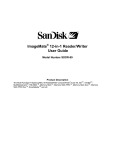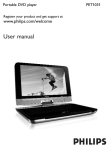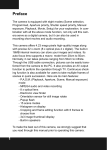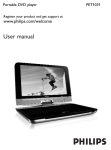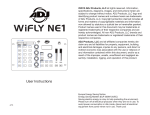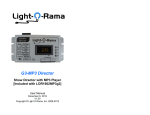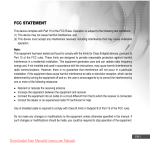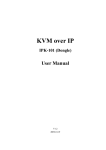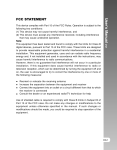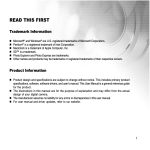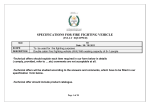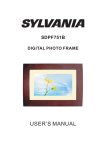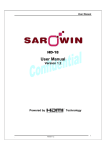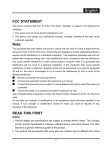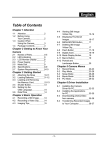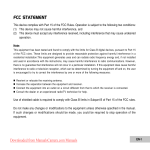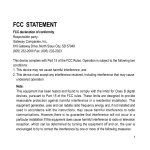Download English
Transcript
English User’s Manual English FCC STATEMENT This device complies with Part 15 of the FCC Rules. Operation is subject to the following two conditions: (1) This device may not cause harmful interference, and (2) This device must accept any interference received, including interference that may cause undesired operation Note: This equipment has been tested and found to comply with the limits for Class B digital devices, pursuant to Part 15 of the FCC rules. These limits are designed to provide reasonable protection against harmful interference in a residential installation. This equipment generates, uses and can radiate radio frequency energy and, if not installed and used in accordance with the instructions, may cause harmful interference to radio communications. However, there is no guarantee that interference will not occur in a particular installation. If this equipment does cause harmful interference to radio or television reception, which can be determined by turning the equipment off and on, the user is encouraged to try to correct the interference by one or more of the following measures: Reorient or relocate the receiving antenna Increase the separation between the equipment and receiver Connect the equipment into an outlet on a circuit different from that to which the receiver is connected Consult the dealer or an experienced radio/TV technician for help Use of shielded cable is required to comply with Class B limits in Subpart B of Part 15 of the FCC rules. Do not make any changes or modifications to the equipment unless otherwise specified in the manual. If such changes or modifications should be made, you could be required to stop operation of the equipment. 2 TRADEMARK INFORMATION Microsoft® and Windows® are U.S. registered trademarks of Microsoft Corporation. Pentium® is a registered trademark of Intel Corporation. Macintosh is a trademark of Apple Computer, Inc. SDTM and MMCTM are trademarks. Other names and products may be trademarks or registered trademarks of their respective owners. READ THIS FIRST Notice: 1. Product design and specifications are subject to change without notice. This includes primary product specifications, software, software drivers, and user’s manual. This User Manual is a general reference guide for the product. 2. The product and accessories that come with your camera may be different from those described in this manual. This is due to the fact that different retailers often specify slightly different product inclusions and accessories to suit their market requirements, customer demographics, and geographical preferences. Products very often vary between retailers especially with accessories such as batteries, chargers, AC adapters, memory cards, cables, carrying cases/pouches, and language support. Occasionally a retailer will specify a unique product color, appearance, and internal memory capacity. Contact your dealer for precise product definition and included accessories. 3. The manufacturer assumes no liability for any errors or discrepancies in this user’s manual. 4. For driver updates, refer to our website. 3 User’s Manual English WARNINGS Do not use this camera if it is emitting smoke (or an unusual odor), if it becomes unusually hot to the touch, produces a peculiar noise, or exhibits any other abnormal conditions. Operating the camera in any of these circumstances may cause a fire or an electrical shock. Stop using the camera immediately, turn the camera off and remove the batteries. Contact your dealer or authorized service facility for repairs. Never attempt to repair this camera by yourself, as this may be dangerous. Do not expose the camera to moisture and make sure no water gets into the camera. Take particular care when using the camera under extreme weather conditions, such as rain or snow, or when operating the camera at the beach on near water. Avoid using this camera in places subject to extreme moisture. Do not use the camera if water has entered the camera. Turn the camera off and remove the batteries. Contact your dealer or authorized service facility. Do not continue to use the camera as this may cause a fire or an electrical shock. Do not use the camera if any foreign objects have entered the camera. Turn the camera off, and remove the batteries. Contact your dealer or authorized service facility. Do not continue to use the camera as this may cause a fire or an electrical shock. Do not place the camera in an unstable location such as on a wobbly table or sloping surface where the camera may fall or tip over and cause injury. If the camera has been dropped or damaged, turn the camera off and remove the batteries. Contact your dealer or authorized service facility. Do not continue to use the camera as this may cause a fire or an electrical shock. Do not insert or drop metallic or other foreign objects into the camera through access points. This may cause a fire or an electrical shock. Do not attempt to modify this camera. Do not remove the camera casing. This may cause a fire or an electrical shock. Internal inspection and repairs should only be carried out by an authorized service facility. Never operate this camera in any way while driving a vehicle. This may cause a traffic accident. 4 CAUTIONS Do not place this camera in a location affected by oil fumes or steam, such as near a cooking stove or humidifier. This may cause a fire or an electrical shock. Do not leave this camera in a location subject to extremely high temperatures, such as in a sealed vehicle or in direct sunlight. Exposure to high temperatures may adversely affect the camera case and internal components and may cause a fire. Do not cover or wrap the camera with a cloth or quilt. This may cause heat to build up and distort the camera case and cause a fire. Always use the camera and accessories in wellventilated locations. Handle the camera carefully and do not expose the camera to shock or vibration. Handling the camera roughly may cause a malfunction. Do not use batteries other than those specified for use with your camera. Use of unsuitable batteries may result in the batteries splitting, or leaking and may cause a fire, injury, or soiling of the battery compartment. When placing the batteries into the camera, check the polarity markings on the batteries ( - and + ) to ensure that the batteries are inserted correctly. Incorrect battery polarity will result in camera inoperability and may result in the batteries splitting or leaking and causing a fire, injury, or soiling of the battery compartment. Remove the batteries if the camera will not be used for an extended period of time. The batteries may leak and cause a fire, injury or soiling of the battery compartment. If the batteries leak, clean and wipe the battery compartment carefully and install new batteries. Wash your hands carefully if you touch the battery fluid. 5 User’s Manual English Table of Contents Introduction........................................................................................08 Package Contents Getting to Know the Camera................................................................09 Front View Top View Rear View Bottom View Side View Image LCD Display Icons Input/Output Connectors Getting Started....................................................................................11 Power - Inserting Batteries Using an AC Power Adapter Using a Memory Card Setting the Date and Time Attaching the Hand Strap Basic Operations.................................................................................13 Recording a Still Image Recording a Video Clip Viewing Still Image/ Video Clip On Image LCD Display On a TV Monitor Erasing Still Image/ Video Clip Erase One Erase All Setting Image Resolution and Quality Flash Digital zoom Self-Timer Slideshow Display Displaying Thumbnail Images Viewing Image Information Camera Menus....................................................................................20 Record Menu Setup Image Size Quality EV Compensation White Balance 6 Quick View Movie Menu Setup White Balance EV Compensation Play Menu Setup Slide Show Erase Copy To Card DPOF Setup Menu Factory Setup Date/Time Language Sound Format Media Video Mode USB Configuration Auto Power Off Light Frequency Transferring Recorded Images to Your Computer................................28 System Requirements for Computer Step 1: Installing the USB Driver Step 2: Connecting the Camera to Your Computer Step 3: Downloading Images/Video Clips Using the Camera as a PC Camera.......................................................30 System Requirements for Videoconferencing Step 1: Installing the PC camera driver Step 2: Connecting the Camera to Your Computer Step 3: Running Software Application (for example: Windows Netmeeting) Specifications......................................................................................32 7 User’s Manual English Introduction Thank you for the purchase of the digital camera. With the camera, you will live a whole new camera experience and make photo shooting more interesting and fun. Here below we will guide you through the whole picture taking process, please keep this manual on hand and enjoy your time. Package Contents Carefully unpack your camera and ensure that you have the following items: Common Product Components: Digital camera USB cable Video cable Software CD-ROM User’s manual Camera strap Common (Optional) Accessories: Memory card Camera pouch AC power adapter Batteries Accessories and components vary by retailer. 8 Getting to Know the Camera Front View 1. 2. 3. 4. Viewfinder window Lens Self-timer indicator Built-in flash Top View 1. Shutter button 2. Hand strap holder Rear View 1. 2. 3. 4. 5. Power button Menu button Arrow button (up) Self-timer button Arrow button (down) Flash button OK button Digital zoom button Thumbnail button 6. Mode button 7. Image LCD display 8. Viewfinder 9. LED indicator 1 Bottom View 1. Tripod socket Side View 1. Battery/Card cover 2. Terminal cover 1 2 9 User’s Manual English Image LCD Display Icons Display icons-Still Image Record Mode: Recording mode Remaining battery power Possible number of shot L Flash Mode Image resolution Image quality Self-timer mode Card indicator White balance SD memory card (No indication: Auto) Exposure compensation setting +1.0ev (No indication: 0.0) M Multi Media Card(MMC) Display Icons- Movie Mode: : Movie Mode Possible recording time Display Icons- Still Image Playback Mode: Playback Mode (Still image) DCF Directory-file number DPOF indicator Display icons- Video(movie) Playback Mode: Playback Mode (Video clip) : Input/Output Connectors 1.USB connector 2.Video output connector 3.AC adapter connector 10 2 3 1 Getting Started Power-Inserting Batteries 1. Slide the battery cover in the direction indicated by the arrow on the battery cover. 2. Insert 2 AA batteries with the correct polarity as shown on the inner side of the battery cover. (Note also the decal inside the battery compartment) 3. Close the battery cover. Do not mix battery (use only one battery type at a time) as this may cause poor camera performance fire or explosion. Batteries should be inserted in the battery compartment with the “+” and “-” sides facing correctly. Battery low is indicated by icon blinks for 6 times, and then the camera will automatically power off. Replace with a new set of batteries. To improve battery performance, replace all installed batteries at the same time. Do not drop, puncture or disassemble batteries and keep batteries away from heat. Take out all the installed batteries if they won’t be used for an extended period of time. IMPORTANT Please observe the following precautions as these may cause the battery to split or leak. Do not attempt to charge the alkaline battery. Do not carry or store a battery with objects such as metal pens, necklaces, coins or hairpins as this could become short circuit the positive + and negative - poles of the battery. Do not subject batteries with too strong impacts, such as hitting them with a hammer, stepping on them or dropping them. Using an AC Power Adapter(Optional accessory) 1. Open the terminal cover as shown: 2. Connect one end of the power adapter to the port labelled “DC IN 3V” as illustrated. 3. Plug the other end of the power adapter into a power outlet. (A power supply must provide 3 VDC rated at 2.5 A for proper camera operation). (An AC adapter is an optional accessory and is not usually included with the camera). Use only the specified batteries or AC power adapter with this camera, the use of other power sources may cause a fire, or damage the camera. 11 User’s Manual English Using a Memory Card (Optional accessory) The camera is equipped with 8 MB of internal (built-in) memory. In addition to saving your images in internal memory, you may also store your images on a removable memory card either SD memory card or Multi Media Card (MMC). A memory card is not included with the camera but be purchased at a computer, photo, or electronics store. To insert a memory card: 1. Make sure to turn the camera off. 2. Open the battery/card cover on the side of the camera. 3. Insert a memory card into the memory card slot: Insert the card as indicated by the arrow on the memory card. The face of the memory card will be towards the camera lens. Press the card until you hear a distinctive click. Make sure the memory card has fully seated allowing the cover to be closed. 4. Close the battery/card cover. To remove a memory card, press on the edge of the card momentarily, and release. Setting the Date and Time Follow these steps to set the correct date and time: 1. Power on the camera. 2. Press the button. 3. SETUP will be highlighted, then press the button. The SETUP menu appears. 4. Select DATE/TIME by using the or button, and then press the button. 5. Enter the values of the year, month, day and time fields by using the or button. button after each field is set. Press the Attaching the Hand Strap 1. Insert the thin end of the strap into the strap holder. 2. Pass the other end of the strap through the loop of thin cord and pull the strap tight. 12 DATE/TIME 01:20 mm/dd/yy 01/01/01 11:11 Basic Operations Recording a Still Image To record a still image, perform the following: 1. Power on the camera. 2. Toggle the button to select the mode. 3. Look at the image on the image LCD display or viewfinder to compose your shot. 4. Press the shutter button. L Recording a Video Clip To record a video clip, perform the following: 1. Power on the camera. 2. Toggle the button to select the mode. : 3. Start recording a video clip by pressing the shutter button. The elapsed time is displayed on the image LCD display. To stop recording, press the shutter button. Imaging Tips For successful image, please follow these suggestions. Hold the camera firmly with both hand and brace your elbows lightly against your body. Take care to keep your fingers, hair and the camera strap away from the camera lens. Use the viewfinder or image LCD display to frame your shot. When using the viewfinder,brace the camera against your forehead to stabilize your shot. 13 User’s Manual English Viewing Still Image/Video Clip In the mode, you can view still images/video clips stored in the camera’s internal or card memory on the image LCD display. You can also connect the camera to the TV monitor in this mode to playback the still images/video clips. On Image LCD Display Still Image To view a recorded still image, follow the steps below: 1. Power on the camera 2. Toggle the button to select the mode. The latest captured image (or the starting scene if the latest captured video clip will be displayed) on the image LCD display. 3. Select the image that you want to view by using the or button. To view the previous image, press the button. To view the next image, press the button. Video Clip To view a recorded still image, follow the steps below: 1. Power on the camera. 2. Toggle the button to select the mode. 3. Select the video clip you wish to view by using the or button. 4. Press the shutter button to start. To pause playback at anytime, press the shutter button. To stop playback, press the or button. : To playback the video clip on the computer, we recommend that you use the “Quick Time Player”. This software is free of charge, compatible for Mac and Windows-based computers and can be downloaded from the Web site at www.apple.com. For Quick Time Player usage, please refer to its on-line help for more information. On a TV Monitor Television monitors can be used to playback still image or video clip. 1. Set the appropriate video output mode (NTSC/PAL) corresponding to your TV standard. From the SETUP, select VIDEO MODE. 2. Connect one end of the video cable to the video output connector of your camera. 3. Connect the other end of the video cable to the video port of your television. 4. Turn on the camera and TV. 5. Toggle the 14 button to select the mode. 6. Playback the recorded images the same way as you would playback them on the the image LCD display. The VIDEO OUT function is highly power consumptive. Hence, batteries may be consumed sooner than normal. Erasing Still Image /Video Clip There are two ways to erase images: Erase One and Erase All Recorded images in an SD memory card cannot be erased when it is write-protected. To erase the pictures recorded in the memory card, make sure to insert the card before deletion. ERASE 01:20 ERASE ONE ERASE ALL To erase the pictures recorded in the camera (internal memory), do not insert any memory card or the camera will not be able to read the internal data with an external memory card attached. External memory (memory card) always has priority over internal memory - whenever a memory card is inserted into the camera ,the camera will use the memory card for both capture and playback. ERASE ONE 1. Power on the camera, and toggle the button to select the mode. 2. Select the image/video clip you wish to delete by using the or button. 3. Press the button. 4. Use the or button to select ERASE, and then press the button. 5. Select ERASE ONE by using the or button, and then press the button. 6. “ERASE CURRENT?” will be displayed in the image. 7. Press the button to delete this image/ video clip. The next image/video clip appears. If you want to cancel the deletion, toggle the button to any other mode. ERASE 01:20 ERASE ONE ERASE ALL ERASE CURRENT? button to exit from menu mode or toggle the 15 User’s Manual English ERASE ALL 1. Power on the camera, and toggle the button to select the 2. Press the button. 3. Use the or button to select ERASE, and then press the button. 4. Select ERASE ALL by using the or button, and then press the button. The ERASE ALL menu appears: 5. Use the or button to select YES. 6. To confirm deletion, press the button. mode. ERASE ALL01:20 YES NO Setting Image Resolution and Quality Resolution and quality settings determine the pixel size (dimension), image file size, and compression ratio for your images. These settings affect the number of images that can be stored in the memory, or on a memory card. As you get to know the camera, it is recommended that you try each quality and resolution setting to get an appreciation for the effects that these settings will have on your images. Higher resolution and higher quality images offer the best photographic results but produce large files sizes. Therefore, fewer images will take up more memory space. High resolution and quality settings are recommended for printed output and situations requiring the finest detail. Lower resolution/quality images take up less memory space and may be quite suitable for sharing images via e-mail, in a report, or on a web page. To change image resolution and quality settings: 1. Power on the camera. 2. Toggle the button to select the mode. 3. Press the button. 4. Move to IMAGE SIZE or QUALITY with the or button and press the 5. Change the settings with the or button and press the button. 16 button. Flash The flash is designed to function automatically when lighting conditions warrant the use of flash. You can take an image using a flash mode suitable to your circumstances. If you change the flash mode, the camera will retain that setting even if the camera is turned off. 1. Power on the camera, and toggle the button to select the mode. 2. Press the button repeatedly until your desired flash mode appears. L 3. Compose the image and press the shutter button. The camera has four flash modes: Automatic Flash, Red-Eye Reduction, Forced Flash (On) and Flash Off. The modes appear, cyclically, when you press the flash button. The table below will help choose the appropriate flash mode: Flash mode Description Auto flash The flash fires automatically according to the ambient lighting conditions. Select this mode for general photography. Red-eye reduction The flash emits a precursor-flash before the main flash fires. This causes the pupil in the human eye to constrict, reducing the red-eye phenomenon. Select this mode when taking images of people and animals in low light conditions. Forced flash Flash off The flash will always fire regardless of the surrounding brightness. Select this mode for recording images with high contrast (backlighting) and deep shadows. The flash will not fire. Select this mode when taking images in a place where flash photography is prohibited, or when the distance to the subject is beyond the effective range of the flash. 17 User’s Manual English Digital Zoom Using digital zoom, images appear closer. Whereas digital zoom is a compelling feature, the more an image is enlarged (zoomed), the more pixilated (grainier) the image will appear. 1. Power on the camera. 2X 2. Toggle the button to select the mode. L 3. Press the button to activate 2X digital zoom function. The 2X icon appears on the image LCD display. 4. Press the shutter button to capture a “zoomed” image. Self-Timer This feature allows you to get into the scene when taking group images. 1. Secure the camera to a tripod or place it on a stable surface. 2. Power on the camera, and toggle the L button to select the mode. 3. Press the button. The icon appears on the image LCD display. 4. Compose the scene. 5. Press the shutter button. The self-timer function is activated. 6. After ten seconds, the camera takes an image. In the first 7 seconds, the self-timer indicator blinks at a rate relatively slow and then blinks rapidly for the last 3 seconds. After an image is taken using self-timer, the self-timer mode is turned off. If you wish to take another image using the self-timer, repeat these steps. Slideshow Display The slideshow function enables you to playback your images back automatically in sequential order as a slide show. This is a very useful and entertaining feature for reviewing recorded images and for presentations. 1.Power on the camera, and toggle the SLIDE SHOW01:20 button to select the mode. 2. Press the button and move to SLIDE 3 SEC SHOW by using the or button, and button. then press the 3. Set the playback interval by using the or button again, and then press the button. The slideshow starts, displaying your images on the image LCD display, one by one, at the set interval. To stop the slideshow display, press the button. 18 You can adjust the slideshow display interval within the range of 1 sec. to 9 sec. For interval setting, refer to SLIDE SHOW in the PLAY MENU. Displaying Thumbnail Images This function allows you to view nine thumbnail images on the image LCD display simultaneously so you may search for a particular image. 1. Power on the camera, and toggle the button to select the mode. 2. Toggle the button until thumbnail screen appears on the display screen. Nine thumbnail images appear (assuming there are nine or more images in memory). To view a full-size image, selecting it by using the or button, and then press the button. Viewing Image Information Image information can be viewed on the image LCD display during image playback. Toggle the Still Image button until image information screen appears on the display screen. SIZE: 1600 x 1200 TIME: 08:59 DATE: 2010.02.14 button Image Information on SIZE : Image resoluttion TIME: Captured time DATE: Captured date 19 User’s Manual English Camera Menus Record Menu The RECORD MENU contains six items: SETUP, IMAGE SIZE, QUALITY, EV COMPENSATION, WHITE BALANCE and QUICK VIEW. Steps to access RECORD MENU, perform 01:20 01:20 RECORD MENU RECORD MENU the following: WHITE BALANCE SETUP QUICK VIEW 1. Toggle the button to select the mode. IMAGE SIZE QUALITY 2. Press the button. The RECORD MENU EV COMPENSATION appears. SETUP For more details, refer to SETUP MENU section. IMAGE SIZE The image resolution (size) determines the size of your image and how many images can be stored in the internal memory or on the memory card. The higher resolution (larger size) produces the large size image but takes up more space in memory. Lower resolution (smaller size) takes up less memory space, suitable for sharing images via email or the Internet. 1. Follow steps 1 through 2 in access IMAGE SIZE01:20 RECORD MENU section. 2. Highlight IMAGE SIZE by using the or L 1600 X 1200 button, and then press the button. S 800 X 600 3. Use the or button again to select the desired image size. 4. Press the button to confirm the selection. QUALITY The image quality determines the compression ratio of your image and how many images can be stored in the internal memory or on the memory card. The higher quality produces the less compressed image but takes up less memory space. Lower quality takes up less memory space, suitable for sharing images via email or the Internet. 1. Follow steps 1 through 2 in access QUALITY 01:20 RECORD MENU section. or 2. Highlight QUALITY by using the NORMAL button, and then press the button. FINE 3. Use the or button again to select the SUPER FINE desired image quality. 4. Press the button to confirm the selection. 20 EV COMPENSATION The camera will automatically adjust the camera shutter speed for the proper exposure of each scene. Occasionally, it is desirable to manually override the automatic exposure value (EV) to accommodate special scene circumstances. 1. Follow steps 1 through 2 in access RECORD 01:20 EV COMPENSATION MENU section. 2. Highlight EV COMPENSATION by using the or button, and then press the button. + 0.0 3. Use the or button again to specify the desired EV. The EV range is from -2.0 to +2.0 in steps of 0.5 EV. 4. Press the button to confirm the selection. WHITE BALANCE Automatic white balance is recommended for most cases. For particular circumstances, you may manually select another white balance preset-according to the ambient lighting conditions. 01:20 01:20 WHITE BALANCE 1. Follow steps 1 through 2 in access WHITE BALANCE AUTO DAYLIGHT RECORD MENU section. TUNGSTEN 2. Highlight WHITE BALANCE by using the FLUORESCENT or button, and then press the button. SHADE 3. Use the or button again to select the desired white balance. 4. Press the button to confirm the selection. QUICK VIEW If Quickview is enabled, each image will be displayed on the LCD momentarily after it is captured. If disabled, each image will not be displayed immediately after capture. 1. Follow steps 1 through 2 in access QUICK VIEW01:20 RECORD MENU section. 2. Highlight QUICK VIEW by using the or ON button, and then press the button. OFF 3. Use the or button again to select ON/ OFF. button to confirm the selection. 4. Press the 21 User’s Manual English Movie Menu The MOVIE MENU contains three items: SETUP, WHITE BALANCE and EV COMPENSATION. Steps to access MOVIE MENU, perform the following: 1. Toggle the button to select the mode. 2. Press the button. The MOVIE MENU appears. SETUP For more details, refer to SETUP MENU section. MOVIE MENU01:20 SETUP WHITE BALANCE EV COMPENSATION WHITE BALANCE Automatic white balance is recommended for most cases. For particular circumstances, you may manually select another white balance preset-according to the ambient lighting conditions. 1. Follow steps 1 through 2 in access MOVIE 01:20 WHITE BALANCE WHITE BALANCE MENU section. AUTO DAYLIGHT EPS_FILTER_BUG TUNGSTEN 2. Highlight WHITE BALANCE by using the FLUORESCENT or button, and then press the button. SHADE 3. Use the or button again to select the desired white balance. 4. Press the button to confirm the selection. EV COMPENSATION The camera will automatically adjust the camera shutter speed for the proper exposure of each scene. Occasionally, it is desirable to manually override the automatic exposure value (EV) to accommodate special scene circumstances. 1. Follow steps 1 through 2 in access MOVIE 01:20 MENU section. EV COMPENSATION 2. Highlight EV COMPENSATION by using the or button, and then press the + 0.0 button. 3. Use the or button again to specify the desired EV. The EV range is from -2.0 to +2.0 in steps of 0.5 EV. 4. Press the button to confirm the selection. 22 Play Menu The PLAY MENU contains five items: SETUP, SLIDE SHOW, ERASE, COPY TO CARD and DPOF. Steps to access PLAY MENU, perform the PLAY MENU 01:20 PLAY MENU 01:20 following: SETUP DPOF SLIDE SHOW 1. Toggle the button to select Play mode. 2. Press the button.The PLAY MENU appears. ERASE COPY TO CARD SETUP For more details, refer to SETUP MENU section. SLIDE SHOW Your camera can display your images sequentially as a slide show at a selected interval. Use the or button to select the slide interval time you desire and then press the button. [1 sec], [3 sec], [5 sec], [7 sec], [9 sec] Refer to section in this manual titled SLIDESHOW DISPLAY for further detail. ERASE This option allows you to delete one image/video clip or delete all images/video clips the memory at one time. If you wish to delete the images or video clips in the internal memory, ensure that the memory card is not inserted in the camera. Otherwise, you will delete the images or video clips stored in the memory card. ERASE ONE This option allows you to delete one image/video clip. Refer to section in this manual titled ERASE ONE on ERASING STILL IMAGE/VIDEO CLIP section for further detail. ERASE ALL This option allows you to delete all images/video clips the memory at one time. Refer to section in this manual titled ERASE ALL on ERASING STILL IMAGE/VIDEO CLIP section for further detail. 23 User’s Manual English COPY TO CARD This feature allows you to copy your images from the camera’s internal memory to a memory card. Of course, you can only do this if you have a memory card installed and some images in the internal memory. 01:20 COPY TO CARD 1. Follow steps 1 through 2 in access PLAY MENU section. YES 2. Highlight COPY TO CARD by using the or NO button, and then press the button. 3. Use the or button again to select YES. 4. Press the button to confirm the selection. DPOF (Digital Print Order Format) DPOF allows you to embed printing information on your memory card. Using DPOF you can select an image to be printed and then specify how many prints to you would like. Take your memory card to a DPOF enabled printer that accepts memory cards. The DPOF/cardcompatible printer will read the embedded information on the memory card and print your images as specified. DPOF 01:20 1. Follow steps 1 through 2 in access PLAY MENU section. 0 DISABLE 2. Highlight DPOF by using the or button, and then press the button. 3. Use the or button to select the print quantity (0~9). If quantity is 0, this function is disabled. 4. Press the button to confirm the selection. 1~9 ENABLE 01 Setup Menu The SETUP menu is shared by all three modes. Users can invoke the SETUP menu by using the button in all three modes. SETUP 01:20 FACTORY SETUP DATE/TIME LANGUAGE SOUND 24 SETUP 01:20 FORMAT MEDIA VIDEO MODE USB CONFIG AUTO POWER OFF SETUP 01:20 LIGHT FREQUENCY FACTORY SETUP Sets whether or not to return the settings to their original factory settings. 1. Toggle the button to the / / mode. 2. Press the button. 3. Highlight SETUP, press the button. The SETUP MENU appears. 4. Use the or button to highlight FACTORY SETUP, and then press the button. 5. To reset to default settings, use the or button again to select YES. 6. Press the button to confirm the selection. 01:20 FACTORY SETUP VER_### ARE YOU SURE? YES NO DATE/TIME Sets the date and time. Refer to section in this manual titled SETTING THE DATE AND TIME for further detail. LANGUAGE Sets the OSD menu language. 1. Follow steps 1 through 3 in FACTORY SETUP section. 2. Use the or button to highlight LANGUAGE, and then press the 3. Use the or button again to select the desired language. 4. Press the button to confirm the selection. LANGUAGE01:20 ENGLISH button. LANGUAGE01:20 FRANCAIS DEUTSCH ESPANOL ITALIANO SOUND Enables/disables the sound effects. The camera produces a sound (beep) each time you press the camera button if this function is enabled. SOUND 01:20 1. Follow steps 1 through 3 in FACTORY SETUP section. ON 2. Use the or button to highlight SOUND, OFF and then press the button. 3. Use the or button again to select ON/ OFF. 4. Press the button to confirm the selection. 25 User’s Manual English FORMAT MEDIA Formats the memory card and erases all data from the card. 1. Follow steps 1 through 3 in FACTORY 01:20 FORMAT MEDIA SETUP section. 2. Use the or button to highlight FORARE YOU SURE? MAT MEDIA, and then press the button. 3. Use the or button again to select YES/ YES NO. NO 4. Press the button to confirm the selection. An SD memory card cannot be formatted if it is write-protected. VIDEO MODE Sets video output type. The camera provides 2 different video output types for your selection: NTSC and PAL. Select the correct video type for the connected device (e.g. NTSC TV or PAL TV). 1. Follow steps 1 through 3 in FACTORY VIDEO MODE01:20 SETUP section. NTSC 2. Use the or button to highlight VIDEO MODE, and then press the button. PAL 3. Use the or button again to select NTSC/PAL. 4. Press the button to confirm the selection. USB CONFIGURATION This menu contains two modes, including DISK DRIVE and PC CAMERA. DISK DRIVE: This mode allows to transfer pictures to the computer. PC CAMERA: This mode allows to use netmeeting/video conference. 1. Follow steps 1 through 3 in FACTORY USB CONFIG01:20 SETUP section. DISK DRIVE 2. Use the or button to highlight USB CONFIG, and then press the button. PC CAMERA 3. Use the or button again to select DISK DRIVE/PC CAMERA. button to confirm the selection. 4. Press the 26 AUTO POWER OFF You may specify or cancel a power-off time. 1. Follow steps 1 through 3 in FACTORY SETUP section. 2. Use the or button to highlight AUTO POWER OFF, and then press the button. 3. Use the or button again to select the desired setting. 4. Press the button to confirm the selection. 01:20 AUTO POWER OFF 1 MIN 3 MIN 5 MIN 10 MIN CANCEL LIGHT FREQUENCY The camera supports different lighting frequencies: 50Hz and 60Hz. When photography under fluorescent lighting, select the correct frequency setting depending on your local area's voltage. However, under other lighting situation, select "disable" for this setting. 1. Follow steps 1 through 3 in FACTORY 01:20 SETUP section. LIGHT FREQUENCY 2. Use the or button to highlight LIGHT 50 Hz FREQUENCY,and then press the button. 3. Use the or button again to select the desired setting. 4. Press the button to confirm the selection. 60 Hz DISABLE Before taking pictures, preview the image with both 50Hz and 60Hz and compare the results. 27 User’s Manual English Transferring Recorded Images to Your Computer You can share recorded images/video clips with your family or friends via e-mail or post them on the Web. Before doing those things, you need to connect the camera to your computer by using the USB cable and then transfer the images/video clips. To transfer images/video clips from the camera to your computer, follow the steps below. Step 1: Installing the USB driver Step 2: Connecting the camera to your computer Step 3: Downloading images/video clips System Requirements for Computer System requirements (Windows) System requirements (Macintosh) CPU Pentium® processor or higher Power PC G3 processor 266MHz or higher OS Windows 98/98SE/Me/2000/XP OS 8.6 or later Memory 32MB RAM(64MB recommended) 32MB RAM(64MB recommended) Free Space on Hard Disk 128 MB hard disk space 128 MB hard disk space Required Devices A CD-ROM drive, An available USB port A CD-ROM drive, An available USB port Color Monitor Color monitor Color monitor (800x600, 24-bit or higher recommended) (800x600, 24-bit or higher recommended) Step 1: Installing the USB Driver The USB driver on the supplied CD-ROM is for Windows 98 and Mac OS 8.6. 1. Insert the CD-ROM packaged with the camera into the CD-ROM drive. 2. Follow the on-screen instructions to complete the installation. 3. Restart your computer. Step 2: Connecting the Camera to Your Computer 1. Power on the camera. 2. Connect one end of the USB cable to an available USB port on your computer. 3. Connect the other end of the USB cable to the USB connector on the camera. 4. The USB CONFIG menu appears on the image LCD display. 5. Select DISK DRIVE by using the or button, and then press the button. DISK DRIVE is displayed on the image LCD display. 6. Look for a new “removable disk” appearing in the “My Computer” window. Your recorded images/video clips will be in a folder on this “removable disk”. (For Mac users, doubleclick the “untitled” disk drive on the desktop.) 28 Step 3:Downloading Images/Video Clips When the camera is turned on and connected to your computer, it is considered to be one disk drive. You can download images/video clips by copying them from the “removable disk” (“untitled” disk on a Macintosh) to your hard drive or other storage disk. For computers running Windows Open the “removable disk” by double clicking on it. Double click on the folder. Your images are inside the folder(s). Select the images that you want, then choose Copy from the Edit menu. Open the destination location and choose Paste from the Edit menu. You may also drag and drop image files from the camera to a desired location. For computers running Mac OS Open the “untitled” disk window and the hard disk or the destination location. Drag and drop from the camera disk to the desired destination. 29 User’s Manual English Using This Camera as a PC Camera This camera can act as a PC camera, allowing you to hold a videoconference and talk to business associates over the Internet or corporate Intranet, or conduct real-time conversation with friends or family. To use this camera as a PC camera, follow the steps below: Step 1: Installing the PC camera driver Step 2: Connecting the camera to your computer Step 3: Running software application (for example: Windows NetMeeting) System Requirements for Videoconferencing To use this camera for videoconferencing, your computer must contain the following components: Microphone Sound card Speakers or headphones Network connection Step 1: Installing the PC Camera Driver The PC camera driver on the supplied CD-ROM is exclusively for Windows. The PC camera function provided on this camera is not supported by Macintosh platform. Step 2: Connecting the Camera to Your Computer 1. Power on the camera. 2. Connect one end of the USB cable to an available USB port on your computer. 3. Connect the other end of the USB cable to the USB connector on the camera. 4. The USB CONFIG menu appears on the image LCD display. 5. Select PC CAMERA by using the or button, and then press the button. PC CAMERA is displayed on the image LCD display. 6. Position the camera steadily on top of your computer monitor. 30 Step 3: Running Software Application (for example: Windows NetMeeting) To use Windows NetMeeting for videoconferencing: 1. Launch Windows NetMeeting. (Start > Programs > Accessories > Communications > NetMeeting) 2. Click the Start Video button to view live video. 3. Click the Place Call button. 4. Type the e-mail address or the network address of the computer that you are calling. 5. Click Call. The person you are calling must have Windows NetMeeting running and also accept your call to start the videoconference. For more information about the operation of videoconference application software, refer to its respective software help. 31 User’s Manual English Specifications Item Sensor Color depth Resolution Description 2.0 megapixels CMOS 10-bit 1600x1200 pixels 800x600 pixels Compression method JPEG File format Exif(ver. 2.1), DCF(ver. 1.0), DPOF(ver. 1.0), AVI(Motion-JPEG) LCD 1.5" color LCD Self-timer 10 seconds delay Zoom 2x digital zoom Capture modes Still photographs or video recording Memory type 8 MB internal memory SD memory card / Multi Media Card (MMC) Flash effective range 1.2m~2.1m Lens Fixed Focus Focal length: f= 9.0mm Aperture: F3.0 Focal range 1.5m ~infinity Exposure compensation Auto; Manual: -2.0 ~ +2.0EV (0.5EV step) White balance Auto, Tungsten, Fluorescent, Shade(Cloudy), Daylight Interface AC adapter connector, USB connector, Video output connector (NTSC or PAL) Power 2 AA Alkaline (1.5V) or Ni-MH (1.5V) batteries, one CRV3 Lithium battery pack (3V), or AC power adapter (2.5A/3.3V) Dimensions 108mm x 56mm x 37mm Weight 125g *Design and specifications are subject to change without notice. 32
































